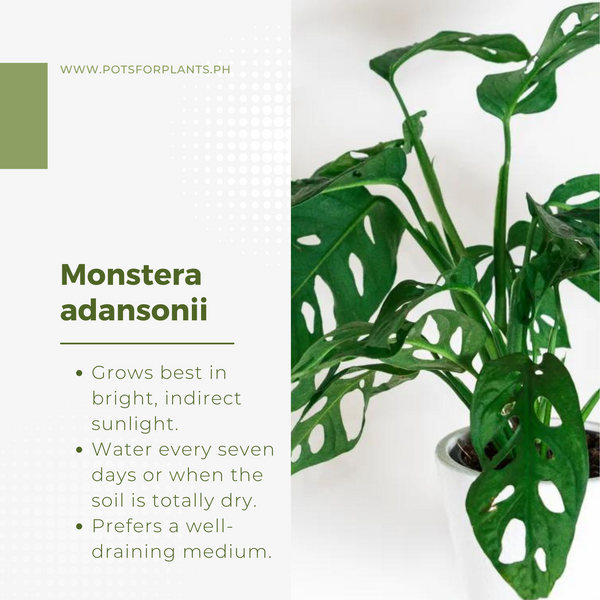It’s no secret that the Monstera deliciosa has become quite popular during the last few years. The Monstera deliciosa, after all, is one of the most gorgeous house plants in existence, with its fenestrated leaves immediately adding an exotic vibe to any space it’s put in.
It also helps that the Monstera deliciosa isn’t nearly as fussy as others: just place it somewhere that gets bright indirect light and give it some water when it looks thirsty, and you’re basically good to go.
However, did you know that there are other Monstera species that you can add to your plant collection?
Here are some Monstera species that you should know about, as well as tips on how to take care of them:
Monstera adansonii - Also known as the Swiss cheese vine, Monstera adansonii is a fairly common plant that’s quite easy to care for. Just like the Monstera deliciosa, Monstera adansonii prefers bright, indirect sunlight, as well as weekly waterings. Given its vining and climbing nature, the Monstera adansonii grows best when trained on a trellis or coco-pole, as these structures best mimic the plant’s natural environment.

Monstera pinnatipartita - Much rarer than the Monstera deliciosa or the Monstera adansonii, Monstera pinnatipartita is native to Colombia, and is known for its deep fenestrations which actually reach the leaves’ midribs. Similar to the Monstera deliciosa, this plant grows best when given bright, indirect sunlight, and when planted in a well-draining medium.

Monstera dubia - A rare, lesser-known variety, the Monstera dubia is famous for the changes it undergoes as it transitions from its juvenile stage to adulthood. Juvenile plants, for instance, have small heart-shaped and variegated leaves that lie flat against whatever surface they are growing on. Adult plants, however, lose the variegation and adopt forms similar to the Monstera deliciosa.

Monstera siltepecana - Also known as the Silver Monstera, this vining plant is prized for its gorgeous, silver-tinged, lance-shaped leaves, and is known to require large branches or coco-poles to fully develop. Just like the Monstera deliciosa, this plant requires bright, indirect sunlight, well-draining soil, and weekly waterings.

Monstera obliqua - One of the rarest (and most expensive) Monstera species on the market, this plant greatly resembles the Monstera adansonii — if the latter’s fenestrations were taken to the extreme that is. Aside from its price, another thing that differentiates this plant from other Monsteras is its care requirements. For instance, it prefers constant, substantial humidity. This is because its leaves can easily dry right out and get crumbly when exposed to dry air.

Rhaphidophora tetrasperma - While not a true Monstera by any means (this plant actually belongs to a different genus native to Southeast Asia), Rhaphidophora tetrasperma actually shares many characteristics with its larger lookalikes, including cute split leaves, ease of care, climbing and trailing nature, and fast growth rate.

Need more help with your plants? Read our blogs for more plant keeping tips and tricks!
Banner Photo by NordWood Themes on Unsplash





